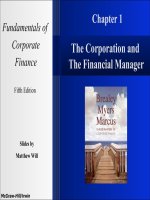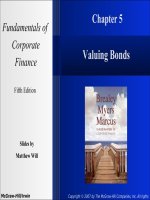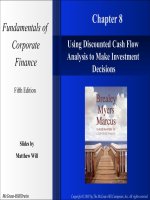Fundamentals of corporate finance 5e mcgraw chapter 07
Bạn đang xem bản rút gọn của tài liệu. Xem và tải ngay bản đầy đủ của tài liệu tại đây (1.36 MB, 35 trang )
Fundamentals of
Corporate
Finance
Chapter 7
Net Present Value and
Other Investment Criteria
Fifth Edition
Slides by
Matthew Will
McGraw-Hill/Irwin
Copyright © 2007 by The McGraw-Hill Companies, Inc. All rights
7- 2
Topics Covered
Net Present Value
Other Investment Criteria
Mutually Exclusive Projects
Capital Rationing
McGraw-Hill/Irwin
Copyright © 2007 by The McGraw-Hill Companies, Inc. All rights
7- 3
Net Present Value
Net Present Value - Present value of cash
flows minus initial investments.
Opportunity Cost of Capital - Expected rate
of return given up by investing in a project
McGraw-Hill/Irwin
Copyright © 2007 by The McGraw-Hill Companies, Inc. All rights
7- 4
Net Present Value
Example
Q: Suppose we can invest $50 today & receive $60
later today. What is our increase in value?
A: Profit = - $50 + $60
= $10
$10
$50
McGraw-Hill/Irwin
Added Value
Initial Investment
Copyright © 2007 by The McGraw-Hill Companies, Inc. All rights
7- 5
Net Present Value
Example
Suppose we can invest $50 today and receive $60
in one year. What is our increase in value given
a 10% expected return?
60
Profit = -50 +
= $4.55
1.10
$4.55
This is the definition of NPV
McGraw-Hill/Irwin
$50
Added Value
Initial Investment
Copyright © 2007 by The McGraw-Hill Companies, Inc. All rights
7- 6
Net Present Value
NPV = PV - required investment
Ct
NPV = C0 +
t
(1 + r )
C1
C2
Ct
NPV = C0 +
+
+...+
1
2
t
(1 + r ) (1 + r )
(1 + r )
McGraw-Hill/Irwin
Copyright © 2007 by The McGraw-Hill Companies, Inc. All rights
7- 7
Net Present Value
Terminology
C = Cash Flow
t = time period of the investment
r = “opportunity cost of capital”
The Cash Flow could be positive or negative at
any time period.
McGraw-Hill/Irwin
Copyright © 2007 by The McGraw-Hill Companies, Inc. All rights
7- 8
Net Present Value
Net Present Value Rule
Managers increase shareholders’ wealth by
accepting all projects that are worth more than
they cost.
Therefore, they should accept all projects with a
positive net present value.
McGraw-Hill/Irwin
Copyright © 2007 by The McGraw-Hill Companies, Inc. All rights
7- 9
Net Present Value
Example
You have the opportunity to
purchase an office building. You
have a tenant lined up that will
generate $16,000 per year in cash
flows for three years. At the end
of three years you anticipate
selling the building for $450,000.
How much would you be willing
to pay for the building?
McGraw-Hill/Irwin
Copyright © 2007 by The McGraw-Hill Companies, Inc. All rights
7- 10
Net Present Value
$466,000
Example - continued
Present Value
0
$450,000
$16,000
$16,000
1
2
$16,000
3
14,953
14,953
380,395
$409,323
McGraw-Hill/Irwin
Copyright © 2007 by The McGraw-Hill Companies, Inc. All rights
7- 11
Net Present Value
Example - continued
If the building is being
offered for sale at a price
of $350,000, would you
buy the building and what
is the added value
generated by your
purchase and
management of the
building?
McGraw-Hill/Irwin
Copyright © 2007 by The McGraw-Hill Companies, Inc. All rights
7- 12
Net Present Value
Example - continued
If the building is being offered for sale at a price of
$350,000, would you buy the building and what is the
added value generated by your purchase and
management of the building?
16,000 16,000 466,000
NPV = −350,000 +
+
+
1
2
3
(107
. )
(107
. )
(107
. )
NPV = $59,323
McGraw-Hill/Irwin
Copyright © 2007 by The McGraw-Hill Companies, Inc. All rights
7- 13
Payback Method
Payback Period - Time until cash flows recover the
initial investment of the project.
The payback rule specifies that a project be
accepted if its payback period is less than the
specified cutoff period. The following example
will demonstrate the absurdity of this statement.
McGraw-Hill/Irwin
Copyright © 2007 by The McGraw-Hill Companies, Inc. All rights
7- 14
Payback Method
Example
The three project below are available. The company accepts
all projects with a 2 year or less payback period. Show how
this decision will impact our decision.
Project C0
A
B
C
C1
Cash Flows
C2
C3
-2000 +1000 +1000 +10000
-2000 +1000 +1000
0
-2000
0 +2000
0
McGraw-Hill/Irwin
Payback
2
2
2
NPV@10%
+ 7,249
- 264
- 347
Copyright © 2007 by The McGraw-Hill Companies, Inc. All rights
7- 15
Other Investment Criteria
Internal Rate of Return (IRR) - Discount rate at
which NPV = 0.
Rate of Return Rule - Invest in any project offering
a rate of return that is higher than the
opportunity cost of capital.
C1 - investment
Rate of Return =
investment
McGraw-Hill/Irwin
Copyright © 2007 by The McGraw-Hill Companies, Inc. All rights
7- 16
Internal Rate of Return
Example
You can purchase a building for $350,000. The
investment will generate $16,000 in cash flows
(i.e. rent) during the first three years. At the end
of three years you will sell the building for
$450,000. What is the IRR on this investment?
McGraw-Hill/Irwin
Copyright © 2007 by The McGraw-Hill Companies, Inc. All rights
7- 17
Internal Rate of Return
Example
You can purchase a building for $350,000. The investment will
generate $16,000 in cash flows (i.e. rent) during the first three years.
At the end of three years you will sell the building for $450,000.
What is the IRR on this investment?
16,000
16,000
466,000
0 = −350,000 +
+
+
1
2
(1 + IRR )
(1 + IRR )
(1 + IRR ) 3
IRR = 12.96%
McGraw-Hill/Irwin
Copyright © 2007 by The McGraw-Hill Companies, Inc. All rights
7- 18
Internal Rate of Return
Calculating IRR by using a spreadsheet
Year
0
1
2
3
McGraw-Hill/Irwin
Cash Flow
(350,000.00)
16,000.00
16,000.00
466,000.00
Formula
IRR = 12.96% =IRR(B3:B7)
Copyright © 2007 by The McGraw-Hill Companies, Inc. All rights
7- 19
Internal Rate of Return
IRR=12.96%
McGraw-Hill/Irwin
Copyright © 2007 by The McGraw-Hill Companies, Inc. All rights
7- 20
Internal Rate of Return
Calculating the IRR can be a laborious task.
Fortunately, financial calculators can perform this
function easily. Note the previous example.
HP-10B
EL-733A
BAII Plus
-350,000
CFj
-350,000
CFi
CF
16,000
CFj
16,000
CFfi
2nd
16,000
CFj
16,000
CFi
-350,000 ENTER
466,000
CFj
466,000
CFi
16,000
ENTER
16,000
ENTER
{IRR/YR}
IRR
{CLR Work}
466,000 ENTER
All produce IRR=12.96
McGraw-Hill/Irwin
IRR
CPT
Copyright © 2007 by The McGraw-Hill Companies, Inc. All rights
7- 21
Internal Rate of Return
Example
You have two proposals to choice between. The initial proposal (H)
has a cash flow that is different than the revised proposal (I). Using
IRR, which do you prefer?
16
16
466
NPV = −350 +
+
+
=0
1
2
3
(1 + IRR ) (1 + IRR )
(1 + IRR )
= 12.96%
400
NPV = −350 +
=0
1
(1 + IRR )
= 14.29%
McGraw-Hill/Irwin
Copyright © 2007 by The McGraw-Hill Companies, Inc. All rights
7- 22
Internal Rate of Return
Example
You have two proposals to choice between. The initial proposal has
a cash flow that is different than the revised proposal. Using IRR,
which do you prefer?
McGraw-Hill/Irwin
Copyright © 2007 by The McGraw-Hill Companies, Inc. All rights
7- 23
Internal Rate of Return
NPV $, 1,000s
50
40
Revised proposal
30
IRR= 12.96%
20
10
IRR= 14.29%
Initial proposal
0
-10
IRR= 12.26%
-20
8
10
12
14
16
Discount rate, %
McGraw-Hill/Irwin
Copyright © 2007 by The McGraw-Hill Companies, Inc. All rights
7- 24
Internal Rate of Return
Pitfall 1 - Mutually Exclusive Projects
IRR sometimes ignores the magnitude of the project.
The following two projects illustrate that problem.
Pitfall 2 - Lending or Borrowing?
With some cash flows (as noted below) the NPV of the project increases s
the discount rate increases.
This is contrary to the normal relationship between NPV and discount rates.
Pitfall 3 - Multiple Rates of Return
Certain cash flows can generate NPV=0 at two different discount
rates.
McGraw-Hill/Irwin
Copyright © 2007 by The McGraw-Hill Companies, Inc. All rights
7- 25
Project Interactions
When you need to choose between mutually
exclusive projects, the decision rule is simple.
Calculate the NPV of each project, and, from
those options that have a positive NPV, choose
the one whose NPV is highest.
McGraw-Hill/Irwin
Copyright © 2007 by The McGraw-Hill Companies, Inc. All rights









